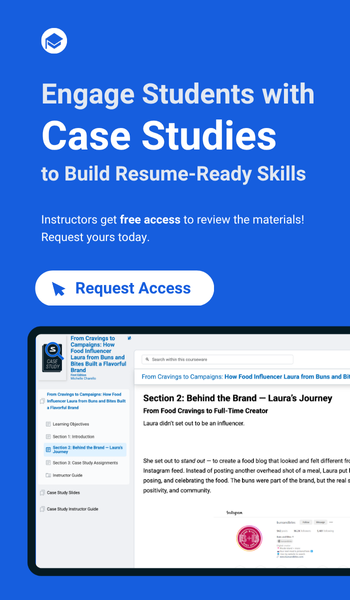The global influencer marketing industry is projected to reach $33.5 billion in 2025, according to Statista. Social platforms such as TikTok, YouTube, and Instagram have shifted the way brands build trust and drive engagement, replacing one-way ads with creator-led storytelling.
Yet, many marketing courses still sideline influencer strategy. But here’s the good news: You don’t have to be an influencer to teach influencer marketing.
This discipline is about more than likes and followers. It’s about audience strategy, brand alignment, and ROI, and that makes it a natural fit for marketing education. Today’s students are entering a workforce that values these skills across brand marketing, PR, digital strategy, and beyond.
This post breaks down the fundamentals, shares classroom-ready activities, and spotlights updates to the Stukent® Social Media Simternship® — now designed to give students hands-on experience in influencer marketing.
Understanding the Modern Influencer Landscape
Let’s define influencer marketing and how it works in practice.
Influencer marketing is a partnership between a brand and an individual with an established, engaged audience. These partnerships often occur on platforms like Instagram, TikTok, YouTube, and LinkedIn, and they’re structured to feel native to the influencer’s content style.
Types of Influencers and Why Follower Count Isn’t Everything
Influencers are often classified by follower count:
- Nano: <10,000 followers
- Micro: 10,000-100,000
- Macro: 100,000-1 million
- Mega: 1 million+
Micro- and nano-influencers often earn higher engagement rates than larger creators. According to Influencer Marketing Hub, micro-influencers cultivate deeper trust within niche communities, making them highly effective for targeted campaigns.
Why Influencer Marketing Works
Consumers crave authenticity. That’s one reason influencer marketing succeeds — it delivers content that feels personal, relatable, and trusted.
As HubSpot reports, “50% of millennials trust product recommendations from influencers,” and a third of Gen Z shoppers have purchased a product based on an influencer’s endorsement.
It’s not just about consumer products either. B2B and service brands are using influencers for thought leadership, event promotion, and employer branding.
Where Influencer Marketing Is Headed
Influencer marketing is maturing. Long-term partnerships, affiliate revenue models, and content licensing deals are becoming more common. AI influencers and avatar creators are entering the mix. At the same time, creators are using platforms such as Upfluence, Later, and Trend.io to manage their brand partnerships.
Teaching Strategies That Make It Real
You don’t need to be on TikTok to teach influencer marketing. You just need to guide students through the strategy behind the content.
Here are a few ways to bring influencer concepts into your course.
Draft an Influencer Campaign Brief
Have students create a campaign brief for a fictional brand, including:
- Campaign goals and key performance indicators
- Target audience and persona alignment
- Influencer characteristics or selection criteria
- Proposed content formats (e.g., Reels, Stories, YouTube Shorts)
This project reinforces the connection between brand strategy and content execution.
Analyze Real-World Campaigns
Choose a few campaigns for discussion and critique.
- Duolingo on TikTok: Known for its viral, self-aware content and humorous use of the brand mascot.
- Dunkin’ + Charli D’Amelio: A full-scale partnership that spanned TikTok, custom drinks, merchandise, and millions of impressions.
- Fenty Beauty: Launched with influencers of all skin tones to drive inclusivity, earning long-term loyalty and massive social traction.
Ask students to evaluate audience fit, creative execution, and measurable impact. Both Adweek and Marketing Dive regularly publish influencer case studies that can support discussion.
Run Outreach and Negotiation Role-Plays
Have students write a cold email to an influencer, then role-play negotiations about deliverables, compensation, and usage rights. It’s a great way to bring business writing and media planning into the discussion.
Classroom Insight for Educators
This exercise doesn’t require students to become creators. The job market needs the strategists behind the campaigns, too.
Level Up with the Social Media Simternship
Want students to practice real-world influencer strategy? The updated Stukent Social Media Simternship makes it easy.
The simulation puts students in charge of Buhi Supply Co.’s social media strategy. As social media managers, they’ll design and execute influencer marketing campaigns, including the following tasks.
Choose Influencers with Real Metrics
Students select influencers from a fictional database, evaluating bios, engagement rates, audience demographics, and platform strengths. They learn to balance reach, fit, and budget to make smart decisions.
Build Creative Briefs and Campaign Assets
The simulation now includes dedicated rounds focused on influencer strategy. Students assemble briefs, plan deliverables, and receive feedback based on realistic KPIs.
Get Data-Driven Feedback
The simulation provides performance metrics for every round. Students see how their influencer choices affect campaign outcomes and learn how to optimize for stronger results in future rounds.
Classroom Insight for Educators
You don’t have to create a simulation from scratch. The Social Media Simternship gives you a structured, turnkey way to teach influencer marketing with clarity and confidence.
You Don’t Need to Be a Creator — Just a Great Educator
Influencer marketing is shaping the future of brand strategy, making it a must-teach topic in today’s marketing curriculum.
Whether students want to manage campaigns, work with creators, or lead brand storytelling, they need to understand how influencer marketing works. Teaching this topic gives them a competitive edge, and you don’t need to be an influencer to lead the way.
With updated tools such as the Social Media Simternship, you can integrate influencer strategy into your course without reinventing your syllabus. Let students explore briefs, campaign decisions, and performance data, practicing the same skills they’ll use in the real world.
Explore the updated Social Media Simternship and “Essentials of Social Media Marketing” courseware here.







